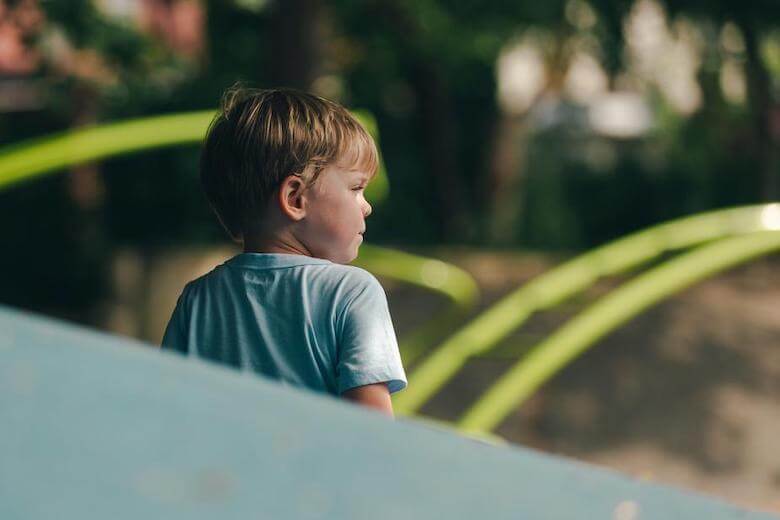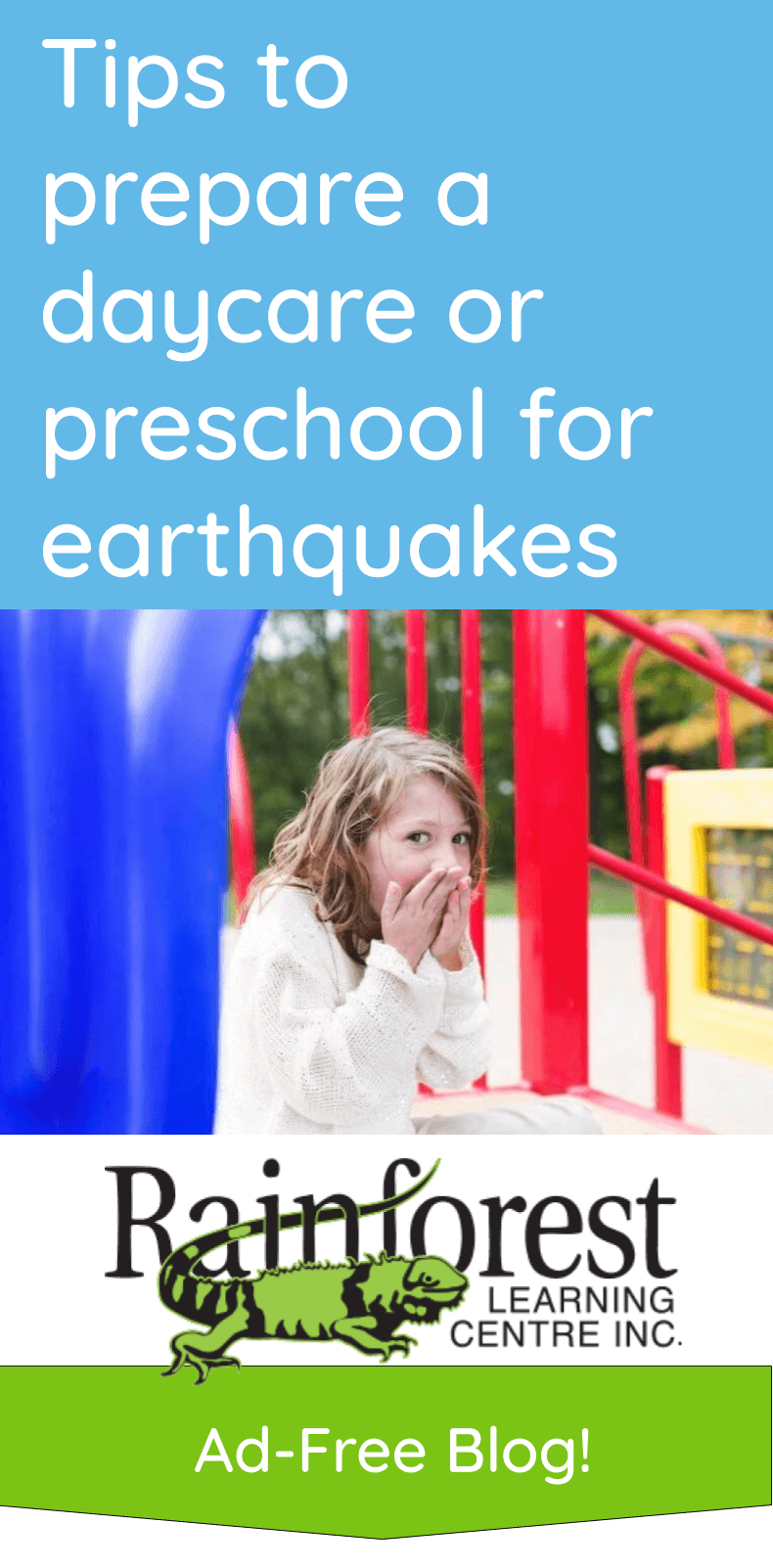
Operating three daycares in the Metro Vancouver and Fraser Valley area (Langley, Coquitlam and North Vancouver), we have our fair share of emergency preparedness training. Preparing a daycare or preschool for earthquakes is one of those emergencies we prepare for, and an important one in B.C., no less. We’ve learned a few things over the years about teaching little tots about earthquakes, and how to be safe during and after one. We’ve also implemented protocols and practices at our centres for early childhood educators, parents and families, that others may find useful to learn about.
Below, we’ll give some tips on how to prepare a daycare or preschool for earthquakes.
Follow regional laws and child care licensing requirements for earthquake and emergency preparedness
First and foremost, we can’t forget to mention that each daycare or preschool should first look up their local laws surrounding emergency preparedness, especially for earthquakes in B.C. Many of these rules and regulations are actually part of child care licensing requirements. In other words, before being able to operate our type of daycares and preschools legally, we must first meet certain safety protocols. These safety measures extend far beyond earthquake emergencies. They span day-to-day possibilities of emergencies too; everything from food safety, to playground safety, plus furniture and water safety, and so on. Even the building structure must meet certain safety requirements.
Our earthquake laws for daycares and preschools include basics that we feel any child care provider should implement (regardless of whether it’s required or not). These include:
- Staff obtaining a first aid certificate and training for on-site emergencies.
- Having at least 3 days worth of food on site for each child (with no additional fees to the parents). Staff should also have sufficient food supplies for emergencies.
- Practicing in earthquake emergency drills on a regular basis (we do them every 3 months).
- Setting up emergency contacts to be available in the event of an earthquake. This way, parents can receive communication about their child from one source.
- Setting up agreed-upon, alternative care providers who are permitted to pick up a child in the event that a parent or primary guardian can not reach the daycare in a reasonable time frame after the earthquake.
- Arranging for a secondary shelter in advance, should our daycare building not be fit for shelter after the earthquake. (e.g. a senior’s home, community centre, hotel or parent’s home that is within walking distance).
- Acquiring parental consent forms to be able to perform any medical or first aid treatments on a child, if necessary, in an emergency. This includes being able to transport the child, or admit them to hospital, or to the care of medical experts.
And so on.
Tell daycare kids what to expect, using language they can understand
While earthquakes can be a hard topic to explain to little kids, it is an important conversation to have. It can be a scary thought to think that ‘bad’ things might happen. However, sugar-coating or avoiding the subject would be counterintuitive, should an earthquake occur while children are in your care. This is why most educational institutions mandate earthquake drills and fire drills. It’s all about ensuring the best possible outcome, should a disaster happen.
So, how do you go about explaining what an earthquake is to kids in early childhood? Their vocabulary and understanding of the world is probably limited at this point in life. Instead of talking about the science of seismic activity, keep things simple.
At our daycare centres, we call an earthquake an “earth shake,” for example. We explain that the earth might shake. And, if that happens, we will all go under a table for a period of time. This is because things might fall over. So, we need to cover our heads to avoid getting hurt. How long do we stay under the table? We can count to 60, or we can sing the alphabet song 3 times.
See related: 5 Easy ways to teach the alphabet to preschoolers
You may be wondering: how do you get a bunch of toddlers and preschoolers to sit still under a table for 60 whole seconds? Good question! We practice! They can do it, believe it or not. Actually, they may even find it fun; you can make it like a game for them.
Above we mentioned earthquake drills. We do these every 3 months so that children and child care staff know what to expect, and what to do in these situations.
Make time for daycare staff earthquake training; all early childhood educators should know their role in an emergency
In addition to doing drills with our toddlers and preschoolers, our early childhood educators, and all staff, are given emergency training, specifically for earthquake preparedness at daycare.
One earthquake preparedness method we use is assigning roles to each person. That way, if an earthquake does happen during daycare hours, everyone knows what their job is. This avoids panic and chaos (as much as possible!). Sample roles and tasks include someone (or multiple people) to:
- Take a roll call and make sure all children and adults are accounted for.
- Check for injuries and apply any first-aid training we are capable of doing.
- Evacuate children out of the building and head the group to an intermediate assembly point. Wait until structural safety checks can be made (another role, described below). Bring a list of parent contacts, emergency phone numbers, child allergies, class roster, etc. (this should be prepared in a ‘go kit,’ in advance).
- Evaluate the daycare building for damage that may pose a safety risk. For example: chemical spills or gas leaks, floods, exposed electrical wires, fires. This person may also need to know how to turn off plumbing, gas, electricity lines or ventilation systems to prevent damage and health risks.
- Bring children to a secondary location, prepared in advance, if the building is unsafe. This is called relocating. This may also be a prior-agreed-upon meeting spot. Staff should also be trained to evaluate the relocation route for hazards such as downed power lines. Also, sheltering-in-place may be safer. Staff should be trained to make a judgement call, or follow instructions from authorities on this matter.
- Put up signs around the building so that parents or parties looking for children know where to find the daycare group.
- Reach out to a contact (usually located out of province) whom parents have been told to call, for updates on the status of the children and daycare. This person may also be the one to make multiple calls for help, while communication lines may be limited, or the daycare staff is busy addressing the immediate needs of the emergency.
- Access and bring out the emergency food and water storage to safe, viable spot.
- Console and comfort the children.
And so on. More information on advised procedures, and overall earthquake preparedness for child care centres, can be read about in this document, by Vancouver Coastal Health.
Given the licensing regulations for running daycares of our size in B.C., we usually have about 6 to 8 child care providers on site each day that we’re open. This gives us the people power to not only care for children in a day-to-day situation, but also in an emergency situation.
Prepare to comfort daycare children in an earthquake emergency
Last, but definitely not least, take care of the emotional state of the children in a disaster situation. Remember, this is going to be a scary time for everyone involved. Adults will know their job. So, to some level, they can control something in the situation. But the children will feel helpless – and that can make the fear worse.
If the only thing children see are adults panicking, that won’t be very reassuring. Neither will yelling at them to follow orders.
Kids in trauma may go into a ‘frozen’ state, or a ‘fight or flight’ state. Because of this, they may not be behaving rationally, or as you would expect. This is a natural stress response. And, trauma in childhood can have symptoms well into adulthood. We definitely don’t want this to occur for any child in our care.
While it’s not our fault that an earthquake may happen, we can do what we can to mitigate the fear and danger that children may be feeling. Keeping them calm will also help caregivers do their job more effectively.
We mentioned roles above. Certainly, at least one person’s role among the daycare staff is to console children in an earthquake situation. This can be as simple as giving lots of hugs, and staying close, so they know they have an adult ‘protector’ to watch over them. This role can also involve distracting kids with games, books or other entertainment. A lot of time spent after the earthquake will likely be sitting around, not doing much – especially for little tots who can’t really help, and are just waiting for parents to pick them up. So in a way, you’ll want to make sure they don’t get bored, and then into mischief either.
The other way to comfort children is to have, on-hand, a personal emergency ‘go kit’ for each pupil in your care. This can include a prior-written letter from the parents to reassure them. It can also contain familiar items, like a food they like, or a favourite book their teacher can read them. Or, perhaps a stone or object they can hold tight as a ‘promise’ that mom and dad are coming for them soon. The new update has
Parents may find it hard to write the consolation letter for their child’s daycare emergency kit. It’s sad and worrisome to imagine your child scared and without mom or dad. So, we advise them to write it as if they were there, next to their child, in that emergency. What would they say? Maybe try to make kids laugh with a family joke. They can let them know to sit tight, not to worry, and that everything will be alright. Of course, a teacher can read the letter to the daycare kids who aren’t literate yet. That’s part of the ‘consolation’ role.
To conclude: preparing a daycare or preschool for earthquakes involves a community
As we’ve seen above, preparing for an earthquake takes more than staff training, or parent notices. It involves the community. Parents will need to arrange for alternate pick ups in case they can’t make it to the daycare within a few hours. So, someone nearby, like a neighbour may be asked to step in. A nearby organization with a facility can also collaborate with a daycare to shelter children if necessary. And, communicating the status of children by text message, social media, phone calls, written signs – or whatever the case may be – will help get them to their parents as quickly as possible. Sometimes, an out-of-province, central contact may need to be assigned this job. They should be ready for this role at all times.
While daycare staff can do the best they can to prepare, sometimes, on-the-spot judgement calls will need to be made ‘in the moment.’ And those moments can be hard to plan for. So, it’s best to learn to work as a team, with the community, and prepare for an earthquake in advance.
See related articles on our blog:
- Basic first aid and emergency response skills to teach in preschool
- What makes a good daycare space design?
- How to teach toddlers and preschoolers to be responsible in an age-appropriate way
- Teaching young kids about stranger safety
- Tips to teach street and road safety at preschool
- How to teach playground safety at daycare
- 5 Tips on how to teach preschoolers about geography at daycare
